The Sigma 30mm f/1.4 is an interesting character. It is the only lens of its kind for any of the common mounts. For APS-C sensors it is very close to a standard lens with a focal length about the same as the sensor diagonal (28mm), and the f/1.4 max aperture is handy for those low light situations.
Construction quality is good. On the Pentax mount it uses the screw drive focus instead of HSM used for other mounts. It has a nice heft to it and everything works smoothly.
Size wise, it is a fairly large prime, but smaller than most zooms. It has about the same physical dimensions as the kit 18-55mm zoom lens, but weighs significantly more. However, given the f/1.4 aperture it is reasonably sized, and is noticeably smaller and lighter than most mid-level standard zooms like the Pentax DA 16-45m 17-70, or Sigma 17-70. It is more compact than many of Sigma's other primes (like the 28mm f/1.8 and 50mm f/1.4) or zooms, as it doesn't use their standard 77mm filter thread body, and instead uses a 62mm thread size. It doesn't have all the wasted space in the lens body like Sigma's other lenses.
Handling
The lens is a joy to use. Focus is quick and accurate with my K-7 with no focus adjustment. It locks quickly and accurately in all lighting situations. Occasionally it will focus confirm on an object completely out of focus, but this behavior can happen with any lens, and it is easily visible in the viewfinder. Usually this only happens with a strong back light or low contrast object. I usually just point the focus indicator to higher contrast edge or reduce the back light in the image and it focuses immediately.My only complaint with the handling is the focus ring turns during auto focus operation. The lens doesn't have manual override and it lacks a switch on the lens to disengage the focus ring. The user needs to be aware of this and never grip the focus ring tightly during operation. Manual focus is well damped, but a tad light. However, it is above average for an AF lens.
Performance
Optically this lens is bi-polar. It has a fair amount of barrel distortion (1.7% barrel) for a standard field of view lens, that can easily be viewed in field situations with straight lines. However, the lens has a strong emphasis on center sharpness that the design leaves the corners very weak at all apertures making the lens not so useful for architecture shots. Performance at f/1.4 near the center of the frame is also excellent, with good contrast even wide open.
There is a bit of focus shift at f/2 to f/4 or so and there is a bit of a trade off between corner sharpness and center sharpness depending on where you focus. The "Partway" graph shows best performance focus and was from a separate focus set as the center data. If you are using the 11 pt focus system, be sure to select the focus point closest to where you are focusing. Focus and recompose will give poor results near wide open with this lens due to the field curvature. The corners and extreme left and right borders are always soft and don't sharpen much beyond f/2.8.
Corner performance drops due to astigmatism and field curvature at f/1.4, but the lens is still usable at the corners for people and portraiture, and other work where high sharpness is not required, see the test picture of the cat with the eyes in the corner of the frame following the conclusion.
However, the images near the corners are not quite as pleasing, as the astigmatism leads to some less than pleasing blur and the chromatic aberration (CA) is higher near the corners, and the CA increases while stepped down.

Flare resistance is excellent. In contra light (a strong light that is shining at the lens) the lens rarely produces any flare spots from internal elements or the aperture, and if it does they are faint octagons. It also has little veiling glare, the reduction in contrast frequently seen in contra light.
Specular highlights are pleasant, but octagon when stepped down. They are fairly uniform in most situations and don't have strong rings around the highlights. See some samples in following the conclusion.
The lens has a strong hot spot if standing in bright light while taking infrared pictures using a Hoya R72 filter (hood was attached). See sample in images following. It helps standing in a shaded area to kill off any flare causing the hot spot.
Conclusion
The Sigma 30mm f/1.4 is a unique beast. It is the only lens of its aperture and focal length, and is relatively low price compared to similar offerings. It is a full f/stop larger aperture than the SMC Pentax FA 35mm f/2, and significantly wider field of view. It offers 1/2 an f/stop over the SMC Pentax FA 31 f/1.8 Limited, and Sigma 28mm f/1.8, and 2 f/stops over the SMC Pentax FA 28mm f/2.8, and none of these lenses surpasses the Sigma 30mm f/1.4 for center sharpness.However, corner performance on the test charts is dismal, and it is unfortunate they don't improve much stepping down the aperture. That being said, I find in real world applications I don't notice the corners being soft, as my subject matter is not usually architecture where the soft corners or barrel distortion become noticeable.
Strengths
- General Purpose (standard field of view)
- Available Light
- Portraiture
- Night (produces nice star bursts)
Weaknesses
- Architecture
- Cityscapes
- Panoramas
- Infrared
Let's face it: how many standard field of view lenses have an f/1.4 aperture for APS-C sensors? None. The SMC Pentax FA 31mm f/1.8 Limited is certainly an excellent lens, but costs nearly three times as much in the US and is 1/2 an f/stop smaller aperture. So even with the weaknesses of the Sigma 30mm f/1.4, I recommend it as a great available light portraiture and all purpose lens.
Test Images
(click on image for full size)Real world center performance at f/1.4
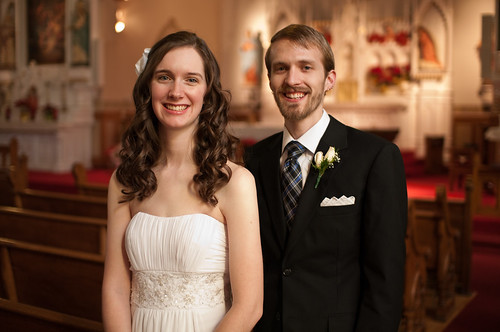
f/1.4, 1/125, ISO 400, K-7
Real world center performance at f/1.4 (image 2)

f/1.4, 1/80, ISO 400, K-7
Real world corner performance at f/1.4

f/1.4, 1/250, ISO 100, K-7
Scene showing soft left and right edges when stopped down

f/6.3, 10", ISO 100, K-7
Scene showing star bursts at f/5.6 (star bursts are natural, but image has other processing for curves, saturation, etc).

f/5.6, 0.8", ISO 100, K-7
Specular Highlights f/1.4
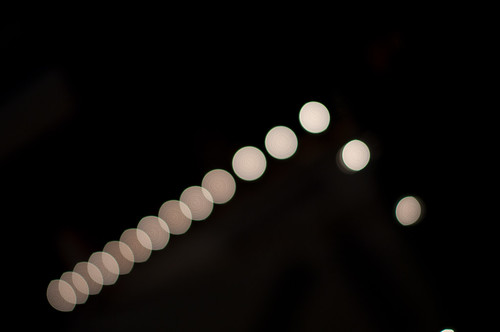
Specular Highlights f/2.8
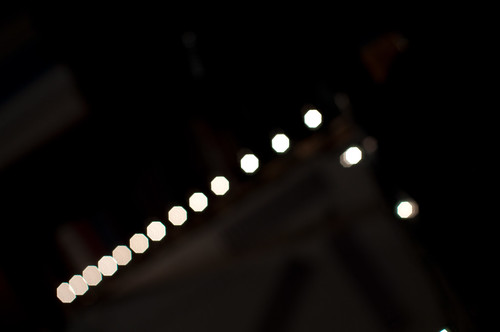
Center focus shot with distracting background at f/1.4
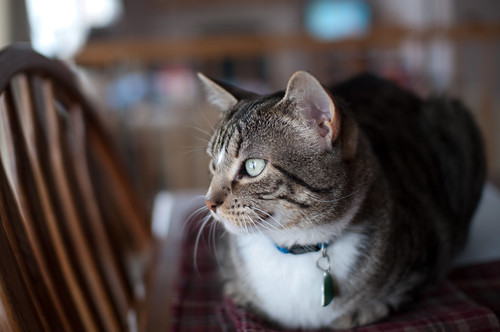
f/1.4, 1/160, ISO 100, K-7
Center focus shot with distracting background at f/4

f/4, 1/80, ISO 400, K-7
Infrared image showing hot-spot, Hoya R72 filter on lens.

f/5.6, 5s, ISO 200, K-7
Infrared image without hot spot (was standing in the shade).

f/1.4, 1/30, ISO 3200, K-7 with Hoya R72, processed in camera
And a bunch more from my flickr photostream.
Sigma 30mm in the center with the Rokinon 85mm f/1.4 on the left and the SMCP A 50mm f/1.4 on the right. A great set of lenses for wedding photography.
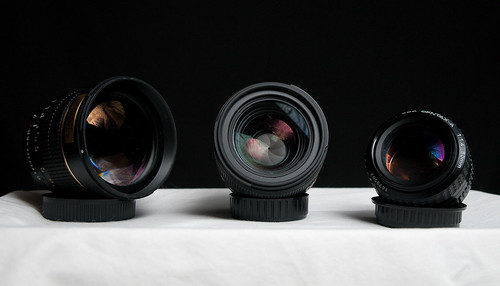


One of the better / more honest reviews I've seen on this lens. Your examples at F 1.4 are very impressive. This will be the last lens I buy.
ReplyDeleteI have one on the way... can't wait to receive it.
ReplyDeleteThanks! I am still enjoying the lens. I updated the charts today. I finally have a much more professional quality setup so I can get more consistent results. Characteristics of the lens still look the same though.
ReplyDeletethank you for this! maybe i get this one for my Nikon D80!
ReplyDeleteGreat review, Eric!
ReplyDeleteI bought this lens recently for my 7d after reading lenstip.com's review. This lens is indeed in a unique industry position being the only one of its kind. However, this demonstrates problems for photographers and/or dslr filmmakers shooting on aps-c/small sensors because options are limited.
I knew that the lens exhibited barrel distortion but thought it wouldn't be a burden. I must admit, it has been. Shooting a 30mm lens on a 28mm diagonal sensor, one would expect straight vertical and horizontal lines (at least fairly straight), but the Sigma has been worrisome. It's disconcerting for me to shoot a 30mm and see the hallmark of a wide or super wide lens. It distorts not only the image but my foresight. Perhaps I'm a little too picky, but for a lens designed specifically for small sensors, I think Sigma dropped the ball a bit here. It behaves just as a 30mm full-frame lens would, which is disappointing. I suppose newer small-sensor lenses of this range will come around eventually.
Anyway, just wonder what your take on this issue is outside of what you mentioned in the review? I find myself trying to shoot around the problem, which no shooter should have to do. Do you happen to do this or do you just go with it? Here's a recent example, snapped candidly by my girlfriend: http://www.flickr.com/photos/59365022@N03/5474222254/
Other than distortion and weak corner performance, it's a great lens. I'm just kind of flustered.
Yeah, it isn't a lens for where you want straight lines. Often the larger aperture lenses suffer from distortion worse than smaller aperture lenses. However, you can use a program like Lightroom3 or Dxo (not sure of full name) or similar program that corrects for lens distortions.
ReplyDeleteI think one of the weaknesses of APS-C sensors is they have to use shorter focal lengths for a "standard" lens. The flange/register distance on most DSLR cameras is about 45mm to be compatible with film cameras and so lenses much wider focal length than that have to be designed a little differently (retrofocus) in order to clear the mirror.
A trick with distortion is to put lines going through the center of the frame. If a horizontal or vertical line is near the edge of the frame it will be obvious if their is distortion. If it runs more through the center point you won't see distortion as much (or at all). This isn't always possible, and that is when distortion correction software comes into play or recomposing the image to avoid the horizontal/vertical lines (like in the candid snapshot).
Eric
FYI, my new review site is:
ReplyDeleteerphotoreview.com and here is a link to the Sigma review with all the test charts.
http://erphotoreview.com/wordpress/?p=3
Well said. I've indeed corrected a few photos in gimp, but my biggest hurdle is with video. I'm a filmmaker who took a gamble on dslr video. Couldn't afford 5d, so went 7d. This has put a strain on my lens options, like you said.
ReplyDeleteAnd you're right about aps-c, it does compromise flange/register.
Now, I just have to decide whether or not to return it. The problem is, what lens could be an equal replacement? Might just have to work with it.
Thanks for the quick response, Eric. Much appreciated.
If you can wait a month or two, Samyang is coming out with their 35mm f/1.4. It is a manual focus lens, but will be affordable (my guess is around $300 or $400 US. I don't know how it performs for distortion yet though. I am sure it will be sold in the US under names like Rokinon, Bower, Vivitar, etc.
ReplyDeletehttp://www.samyang.pl/product,156,category,5,samyang_35_mm_f14_as_umc_available_since_february_2011
It looks like a promising lens, but availability might be short for a while. Otherwise you could look at some Zeiss lenses (expensive) or other modern manual focus lenses like voigtlander.
How large of an aperture do you need? You might get less distortion going with something a little slower or longer (like a 35/2 lens).
Eric
Ha, can't believe I hadn't heard about that Samyang 35mm. Since I do a lot more photography now, I really enjoy having HSM autofocus, but I'll definitely look into this new 35.
ReplyDeleteI've looked into voigtlander and Zeiss both. Zeiss is usually far out of my price range, like any Canon L series.
I don't necessarily need a 1.4 aperture, but it is really nice to have in case I need that extra light or even for aesthetic purposes.
The only thing that turns me off the Samyang is the lack of autofocus. Before my 7d I rarely autofocused, but I've found it extremely useful for most of my photography.
Jon
I agree, autofocus is nice. It tends to be difficult to manually focus f/1.4 lenses as well. I figured for video though manual focus might be okay (depending on what kind of video you do).
ReplyDeleteYou could always look at the Canon 35/2 if you want an affordable AF lens that has less distortion than the Sigma (but not as large of aperture).
Eric
Agreed, manual focus at 1.4 is tricky. I can always zoom digitally in live view, but that's time consuming. The Samyang would be an excellent lens for video use, certainly. I'm just a little apprehensive because I've been shooting more photos than video lately. Just something for me to consider.
ReplyDeleteI'm definitely curious about the Canon 35/2. I'll look into it.
Jon
Great review. We've posted one at our blog here, feel free to take a look: http://www.aputure.com/blog/2011/03/08/sigma-30mm-f1-4-lens-review-with-samples/
ReplyDelete